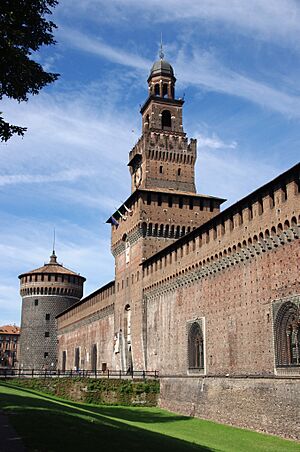List of governors of the Duchy of Milan facts for kids
Quick facts for kids Governor of MilanItalian: Governatore di Milano |
|
|---|---|
 |
|
| Residence | Castello Sforzesco |
| Appointer | Council of Italy (1526–1706) Emperor of Austria (1726–1800) |
| Formation | 6 July 1526 |
| First holder | Charles III |
| Final holder | Luigi Cocastelli |
| Abolished | 1800 |
The Governor of Milan was an important job in the Duchy of Milan. This person was like a special representative for foreign kings and emperors who ruled Milan. This role existed from the 1500s until Italy became one country. The first Spanish Governor was chosen after the last Duke from the House of Sforza family, Francesco II, passed away.
Contents
How the Governors Started
The idea of a Governor for Milan began in 1526. This was right after the Battle of Pavia. Before this, the Kingdom of France had taken over the Duchy in 1499. After the battle, Milan came under the protection of Charles V. This meant Milan was no longer a fully independent state. Instead, it was now looked after by a powerful emperor.
The first person to hold this new role was Charles III. He was governor from 1526 to 1527. Another early governor was Alessandro Bentivoglio, who served from 1531 to 1532.
Milan Under Charles V's Rule
After the Sforza family's rule ended, Charles V took control. He appointed several governors to manage Milan. These governors had both political and military power. They helped Charles V keep his authority in the region.
Some of the notable governors during Charles V's time included:
- Antonio de Leyva, Prince of Ascoli (1535–1536)
- Cardinal Marino Caracciolo (1536–1538)
- Alfonso d'Avalos d'Aquino, Marquis of Vasto (1538–1546)
- Ferdinando Gonzaga, Prince of Molfetta, Duke of Ariano (1546–1555)
- Fernando Álvarez de Toledo, 3rd Duke of Alba (1555–1556)
Spanish Control of Milan
From 1556 to 1706, Spain ruled Milan. During this long period, many Spanish nobles and military leaders served as governors. They were responsible for keeping order and managing the Duchy for the Spanish kings. This was a time when Spain was a very powerful country in Europe.
One governor, Gonzalo II Fernández de Córdoba (1520-1578), served two terms. Another important figure was Pedro Enríquez de Acevedo, Count of Fuentes, who was governor for ten years (1600–1610). These governors often had to deal with wars and political challenges in Europe.
Milan became part of the Austrian Empire on September 26, 1706. This happened during the War of the Spanish Succession. The change in rule was officially confirmed by the Treaty of Rastatt.
Austrian Control of Milan
After the Spanish, Austria took over Milan. This period lasted from 1706 to 1800. Austrian leaders and military figures became the new governors. They managed Milan as part of the large Austrian Empire.
A very famous governor during this time was Prince Eugene of Savoy. He was a brilliant military commander and served from 1706 to 1716. There were also times when other countries briefly occupied Milan. For example, the Sardinians occupied it from 1734 to 1736, and the Spanish from 1745 to 1746.
Later, Francis III, Duke of Modena, became an administrator. He helped manage Austrian Lombardy from 1754 to 1771. Archduke Ferdinand of Austria was also a significant governor, serving from 1771 to 1796.
The last Austrian governor was Count Luigi Cocastelli, who served from 1799 to 1800. The Austrians left Milan after the Battle of Marengo. Milan then became part of the Cisalpine Republic. This republic later became the Italian Republic in 1802 and the Kingdom of Italy in 1805.
In 1814, the Austrians returned to Milan. They combined it with the former Republic of Venice to create a new kingdom called the Kingdom of Lombardy–Venetia. This new kingdom was also ruled by Austrian-appointed leaders.
Images for kids
Sources
- GOBERNACIÓN DEL MILANESADO
- Storia de Milano (it)


